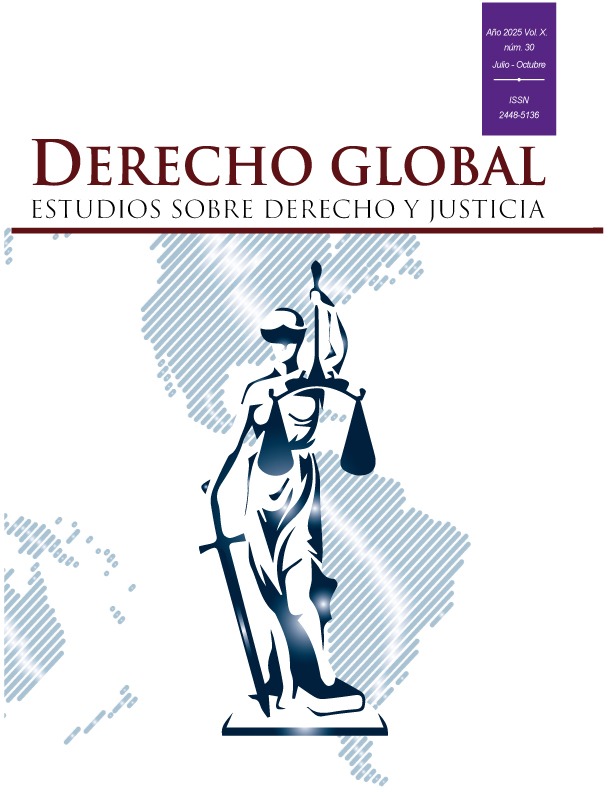Algunas Reflexiones Teóricas sobre las Alteraciones Mentales y la Muerte Permanente como causal de "Extinción Disciplinaria"
Contenido principal del artículo
Resumen
Detalles del artículo

Esta obra está bajo una licencia internacional Creative Commons Atribución-NoComercial-CompartirIgual 4.0.
En este apartado se tratan los asuntos concernientes a los derechos de autor en lo que respecta a la revista, los autores y usuarios.
Se establece en conformidad a lo dispuesto en la Ley Federal del Derecho de Autor, Ley de Ciencia y Tecnología, Ley General de Educación, Ley Orgánica del Consejo Nacional de Ciencia y Tecnología, lo particular del Estado de Jalisco, de la Ley Orgánica, de sus Estatutos y de sus Reglamentos de la Universidad de Guadalajara.
De la revista
- Derecho Global está registrada con el Número de Reserva de Derechos al Uso Exclusivo del Título de la versión electrónica: 04-2015-021708234800-203, e-ISSN: 2448–5136; número de Reserva de Derechos al Uso Exclusivo del Título de la versión impresa: 04-2015-021109191900-102, ISSN: 2448-5128, otorgados por el Instituto Nacional del Derecho de Autor; con número de certificado de Licitud de Título y Contenido 16827 y es editada por la Universidad de Guadalajara.
- Derecho Global protegerá los derechos de autor en lo que respecta a sí misma y de los titulares del contenido en ella publicado. Cualquier violación a los mismos se resolverá en conformidad a lo establecido en la Ley Federal del Derecho de Autor.
De los autores
- Los autores tienen el derecho de colección y al autoarchivo.
- La licencia de uso que otorgan los autores no los priva de publicar sus obras reunidas en colección escogida o completa.
- El derecho de autor no está ligado a la propiedad del objeto material en el que la obra esté incorporada.
Citas
Cf. Greer DM, Shemie SD, Lewis A, et al. Determination of brain death/death by neurological criteria: the world brain death project. JAMA. 2020;324(11):1078-1097. doi:10.1001/jama.2020.11586
Chandler JA, Pope TM (2023). Legal considerations for the definition of death in the 2023 Canadian Brain-Based Definition of Death Clinical Practice Guideline. Can J Anaesth
Chandler JA, Pope TM. Legal considerations for the definition of death in the 2023 Canadian Brain-Based Definition of Death Clinical Practice Guideline. Can J Anaesth. 2023 Apr;70(4):659-670. doi: 10.1007/s12630-023-02410-9. Epub 2023 May 4. PMID: 37142895; PMCID: PMC10202968.
Committee of the Harvard Medical School. A definition of irreversible coma. Report of the Ad Hoc Committee of the Harvard Medical School to Examine the Definition of Brain Death. JAMA. 1968 Aug 5;205(6):337-40. PMID: 5694976.
Chang JJ, Tsivgoulis G, Katsanos AH, Malkoff MD, Alexandrov AV. Diagnostic Accuracy of Transcranial Doppler for Brain Death Confirmation: Systematic Review and Meta-Analysis. AJNR Am J Neuroradiol. 2016 Mar;37(3):408-14. doi: 10.3174/ajnr. A4548. Epub 2015 Oct 29. PMID: 26514611; PMCID: PMC7960140.
Damasio, A. (2023). Y el cerebro creó al hombre (And the brain created man). Booket.
Daza Pérez, Mario Felipe (2023, November 8). The "permanent death" as a cause of "disciplinary extinction": a look from "neuroscience". Available at https://blogdemariodaza.blogspot.com/2023/11/la-muerte-permanente-como-causal-de.html
Daza Pérez, Mario Felipe (2023, April 6). The power of mind and language: can the mental states of offenders, delinquents, and disciplinable subjects be altered through speech? Available at: https://blogdemariodaza.blogspot.com/2023/04/el-poder-de-la-mente-y-del-lenguaje-se.html
Dehaene-Lambertz G, Dehaene S, Hertz-Pannier L. Functional neuroimaging of speech perception in infants. Science. 2002 Dec 6;298(5600):2013-5. doi: 10.1126/science.1077066. PMID: 12471265.
Ecuador – Ministerio de Salud Pública (2016). Protocol for the diagnosis and certification of brain death (2015), Link: https://www.salud.gob.ec/wp-content/uploads/2016/09/Protocolo-muerte-encef%C3%A1lica.pdf which
Escudero, Dolores (2009). Diagnosis of encephalic death. Medicina Intensiva, 33(4), 185-195.
Kanai R, Bahrami B, Duchaine B, Janik A, Banissy MJ, Rees G. Brain structure links loneliness to social perception. Curr Biol. 2012 Oct 23;22(20):1975-9. doi: 10.1016/j.cub.2012.08.045. Epub 2012 Oct 4. PMID: 23041193; PMCID: PMC3510434.
Kanehnman, D. (2021). Thinking fast, thinking slow. Debolsillo.
Society for Personality and Social Psychology (2023, March 27). Positive experiences in close relationships are associated with better physical health, new research suggests. ScienceDaily. Retrieved February 12, 2024, from www.sciencedaily.com/releases/2023/03/230327114815.htm
Lewis A, Kirschen MP, Greer D. The 2023 AAN/AAP/CNS/SCCM Pediatric and Adult Brain Death/Death by Neurologic Criteria Consensus Practice Guideline: A Comparison With the 2010 and 2011 Guidelines. Neurol Clin Pract. 2023 Dec;13(6): e200189. doi: 10.1212/CPJ.0000000000200189. Epub 2023 Oct 11. PMID: 37829552; PMCID: PMC10567121.
Neuroscience New (2020, October 26). Neurocritical Care, entitled: Redefining Death: The Push to Update the U.S. Death Act".
Omelianchuk, Adam (2021). The New Definitions of Death for Organ Donation: A Multidisciplinary Analysis from the Perspective of Christian Ethics by Doyen Nguyen. The National Catholic Bioethics Quarterly. 21. 180-182. 10.5840/ncbq202121118. Constitutional Court (2014). Sentencia C-233.
Pediatric and Adult Brain Death/Death by Neurologic Criteria Consensus Guideline. Report of the AAN Guidelines Subcommittee, AAP, CNS, and SCCM".
Pérez P., Moreno A., Zarco L. (1998). Practical guide for the diagnosis of encephalic death in the emergency department of the Hospital de San Ignacio 1998.
Stijovic, Ana, Paul A. G. Forbes, Livia Tomova, Nadine Skoluda, Anja C. Feneberg, Ekaterina Pronizius, Giulio Piperno, Urs M. Nater, Claus Lamm, and Giorgia Silani. "Homeostatic Regulation of Energetic Arousal During Acute Social Isolation: Evidence From the Lab and the Field." Psychological Science, 2023. https://doi.org/10.1177/09567976231156413.
